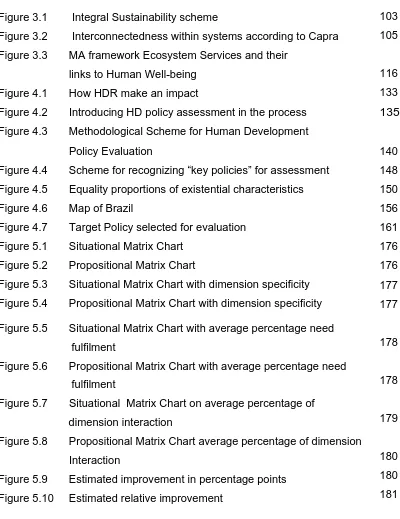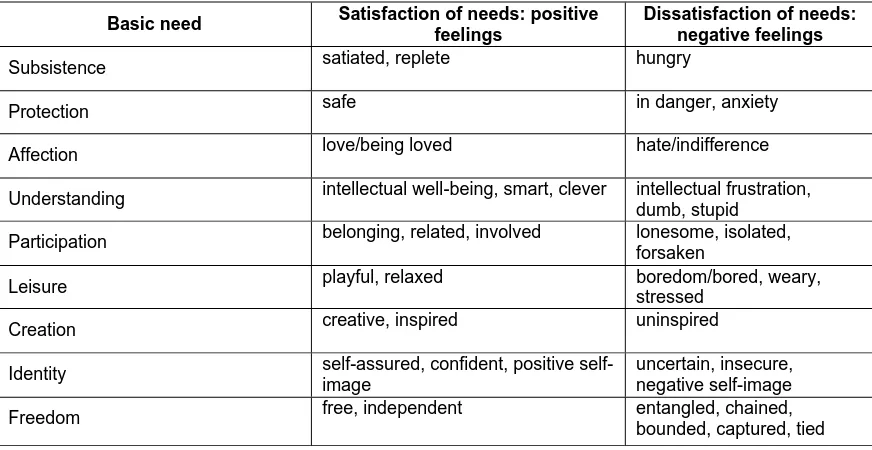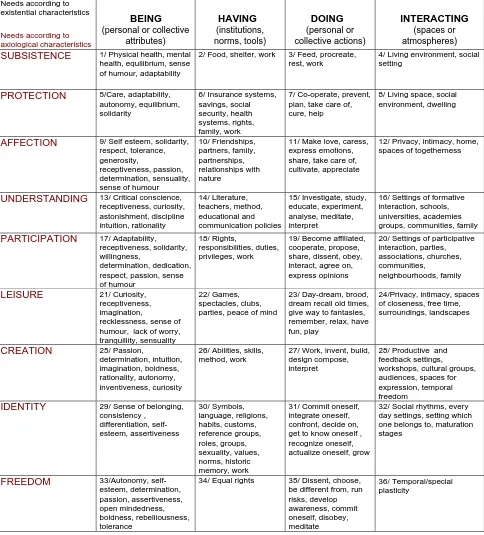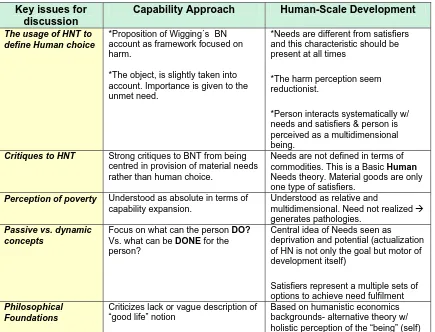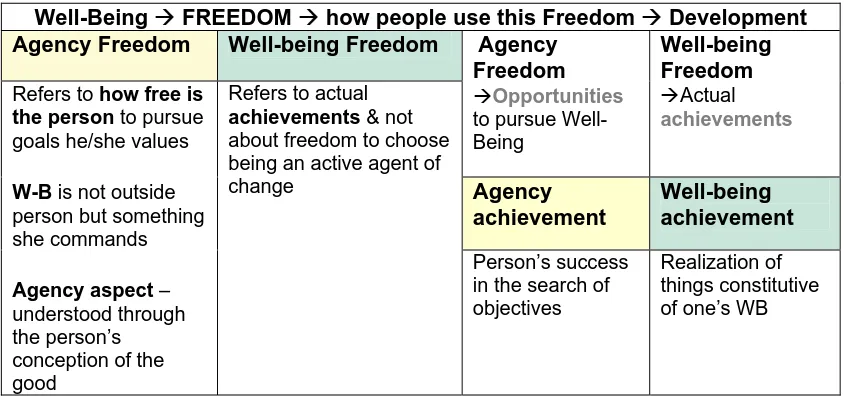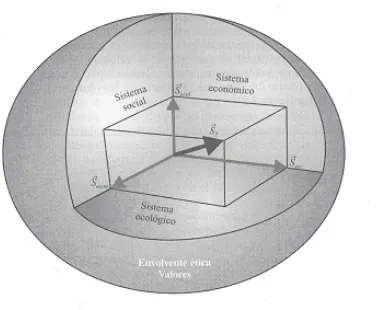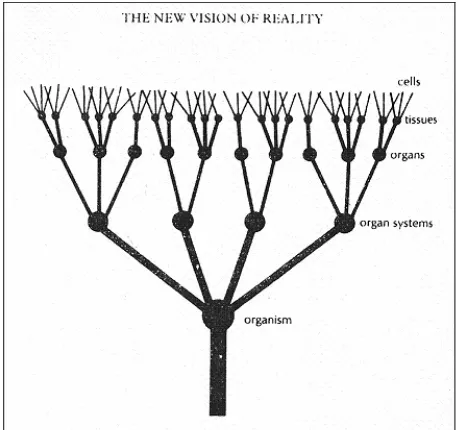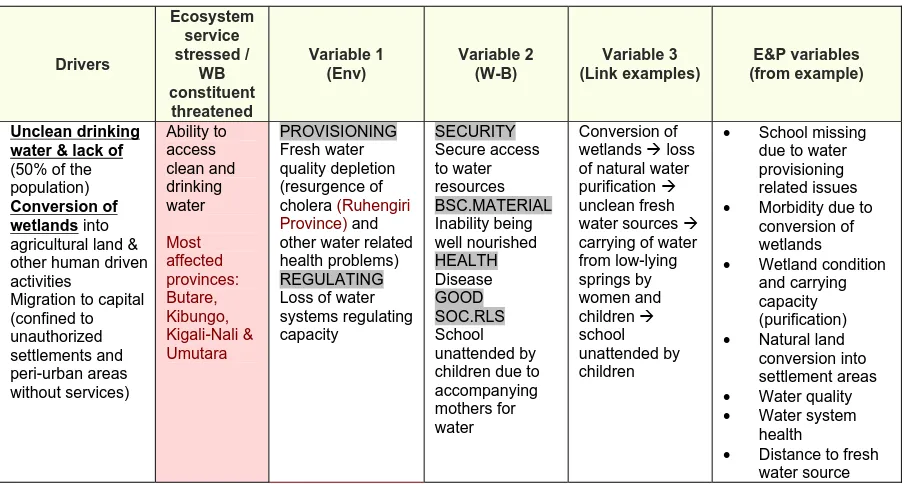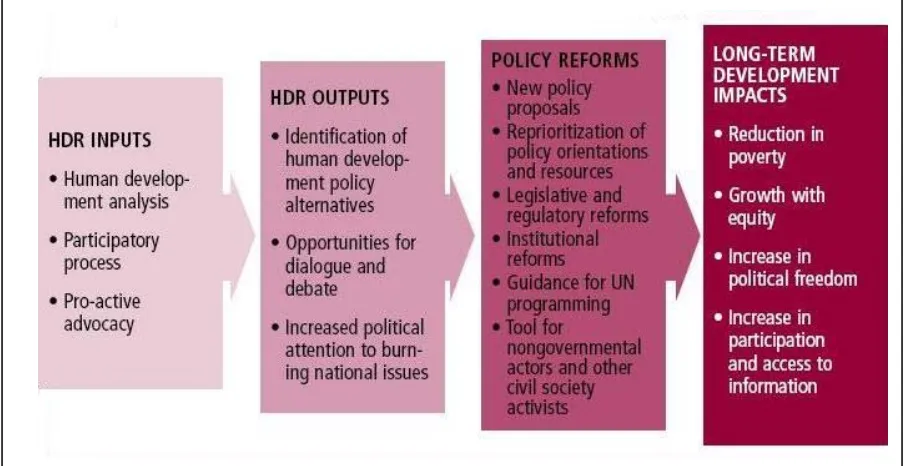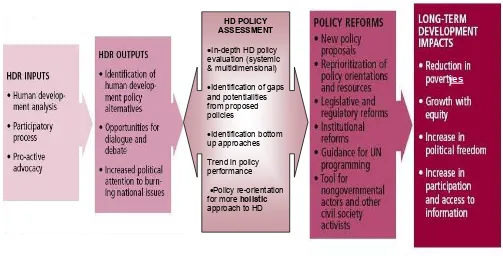“Human Development assessment through the
Human-Scale Development approach: integrating
different perspectives in the contribution to a Sustainable
Human Development Theory”
T E S I S D O C T O R A L
Presentada por
IVONNE CRUZ BARREIRO
Dirigida por
DR. ANDRI STAHEL
2
I have reached the conclusion that I lack the power to change the world,
or any significant part of it. I only have the power to change myself.
And the fascinating thing is that if I decide to change myself, there is
no force in the world that can prevent me from doing so. It is just my
decision and if I want to do it, I can do it!. Now the point is that if I
change myself, something may happen as a consequence that may
lead to a [little] change in the world.
(Manfred Max-Neef)
He llegado a la conclusión de que no poseo el poder de cambiar el
mundo, o una parte significativa de él. Pero creo que sólo tengo el poder
de cambiarme a mi mismo. Lo realmente fascinante, es que si decido
cambiarme a mi mismo no hay ningún poder que pueda impedírmelo.
Es sólo mi decisión y si quiero hacerlo, ¡puedo hacerlo!. Ahora, el punto
está, en que si logro cambiarme a mi mismo, quizá algo suceda, y
como consecuencia esto guíe a algún [pequeño] cambio en este mundo.
4
Agradecimientos,
De todas estas páginas escritas, creo que después de cuatro años de trabajo, ésta es
la página más valiosa e importante de mi tesis.
La gratitud, creo yo, es una de las virtudes mas sublimes del ser humano y sin ella,
todo lo que uno hace, perdería su verdadero valor. A veces uno tarda más en escribir
estos textos por no encontrar palabras adecuadas para agradecer todos aquellos
momentos, coincidencia, instantes, silencios, reflexiones y abrazos a lo largo de este
largo viaje.
En mi caso, todas las personas que de una manera u otra me han apoyado, han hecho
de este camino, más que un logro intelectual, una experiencia verdaderamente
humana; donde sobre todas las cosas he aprendido de la constancia, del trabajo, de la
intuición, la crítica, la amistad, la compañía y el cariño. No sabría por donde empezar,
pero como llegan los momentos a mi mente, así lo hago.
Primero agradezco a la vida, la capacidad del ser humano de generar el
chispazo inicial de la curiosidad; la inquietud por explorar, por aprender y
emprender este camino. Es verdad, que casi siempre es un tanto solitario, pero
en aquellos momentos cuando me di cuenta de que no estaba sola, tuve la
suerte de encontrarme con gente extraordinaria, que dejó en esta experiencia,
recuerdos entrañables.
A los amigos y compañeros del doctorado, con los que compartí el espacio de
trabajo, las comidas y largas conversaciones; a Carlos, Ernesto, Leonardo, Eli,
y Katia. A Iolanda y Dani; y a Marcela por su valiosa ayuda en metodología y
cuestiones de estructura.
A los profesores y coordinadores de la Cátedra, en especial a Enric Carrera y a
Jaume Cendra por su apoyo en tantísimas ocasiones y por que a lo largo de
estos años se ha empezado a construir una relación sincera de amistad y
confianza.
A los colegas y hoy amigos, que conocí en tantos Congresos y Conferencias; a
5
A los profesores y académicos con los que conviví y tuve oportunidad de
conocer y a quienes admiro profundamente; a Asun St. Clair, Des Gasper, Shiv
Kumar, Sakiko Fukuda-Pharr y especialmente a Flavio Comim y Angels Varea
con quienes trabajé y compartí unos meses en el Capability and Sustainability
Centre en la Universidad de Cambridge, Inglaterra.
Al Profesor Manfred Max-Neef a quien tuve el honor de conocer y compartir
algunas ideas, y que me dejó en las manos un puñado de entusiasmo para
concluir esta tesis.
A Andri Stahel quien me regaló tantas horas de su tiempo, su experiencia, sus
opiniones y valiosos comentarios. Sobre todo por su paciencia en leerme, en
interpretar mis ideas, por la gran ayuda y la guía que representó en un principio,
y su capacidad de síntesis al final. Y porque gracias a él conocí la teoría del
desarrollo a escala humana, que hoy es fuente de inspiración de mi trabajo y lo
seguirá siendo muy probablemente en los próximos años.
A Astrid, compañera del alma y de despacho. Por que ella sabe las horas que
hemos dedicado a construir una nueva forma de ver el mundo, de entenderlo y
de compartirlo. Y por que éste trabajo es el resultado de muchas discusiones e
ideas que seguiremos proyectando juntas para que la sostenibilidad sea algo
que entendamos como una inmensidad de posibilidades representadas en una
amplia variedad de dimensiones.
A mi familia por supuesto, que es mi historia y mi referente. Tan lejos y tan
cerca, que en todo momento me han apoyado y motivado a ser quien soy; a
Georgina, Cecy, Mamá y Papá. A mi abuela y al abuelo que perdí en la
distancia (que siempre quiso una nieta doctora), y a mis suegros; Laura y al Dr.
Jorge, que siempre han compartido y apoyado nuestros proyectos.
Por último, mi más profundo agradecimiento es para Jorge, mi otra mitad, a
quien espero pueda devolver todos sus abrazos cuando lo peor y lo mejor
ocurría, y a quien dedico el resto de éstas páginas; pues es él quien estuvo ahí
siempre. Por todos los años que nos quedan por seguir creyendo que podemos
cambiar nuestro pequeño mundo, he aquí este pequeño gran regalo.
6
Acknowledgements
From all the following pages, I believe that after these four years of intensive work, this
one page represents the most valuable thing in the contents of this thesis.
Appreciation is, I believe, one of the most precious virtues and kind feelings of human
nature without which, all the things we do in life will loose their real meaning. People
take longer to write these paragraphs without finding the proper words to thank all the
moments, coincidences, silences, reflections, and hugs received along this long
journey. In my case, all people who have supported me in any way, have made this
intellectual challenge a real humane experience, where overall, I have learned about
essential things in life such as; perseverance, hard working, intuition, critique,
friendship, companionship and care. I would not know exactly where to start, but as
thoughts come to my mind I therefore begin.
First of all, to life, for that intrinsic capacity of human beings of generating the
initial sparkle of curiosity to explore, to learn and start this journey. True is, that
often is quite lonely, but whenever I found that I was not alone, I have been
really lucky to come across extraordinary people. Now I recall this encounters
as treasured moments in this experience.
To the dear friends whom I shared the workplace, lunches and long
conversations and other interesting dissertations; to Carlos, Ernesto, Leonardo,
Eli and Katia. To Iolanda and Dani, and specially to Marcela whose help was
crucial on many methodological issues.
To my professors and coordinators at the UNESCO Chair. Specially to Enric
Carerra and Jaume Cendra for their support in many occasions, but overall for
their friendship and trust.
To all my colleagues, now considered friends, whom I have met in the various
Conferences and Seminars along these years; to Rebeca, Ivette, Toru, Ricardo
and Emma.
To all academics which I have had the great opportunity to meet and share
opinions and whom I respectfully admire; to Asun St. Clair, Des Gasper, Shiv
7
Angels Varea for the time shared and for the opportunity to spend a few months
at the Capability and Sustainability Centre at the University of Cambridge, Uk.
To Professor Manfred Max-Neef, whom I had the honour to meet and share on
some of my ideas and who gently pushed me with great enthusiasm to
conclude this thesis.
To Dr. Andri Stahel who dedicated so many hours of his precious time; for his
experience shared, his opinions and valuable comments. Overall, I thank his
patience and his interest in interpreting my ideas, his help and guidance in the
beginning and his great synthetically skills at the very end. In any case, I thank
him specially for introducing me into the Human–Scale Development approach,
which represents a key inspiration source to my work now and most likely in the
years to come.
To Astrid, dear friend and colleague. Because she knows the long hours that we
have spent talking about the idea of building new ways to understand, see and
share the world. But also because this work is the result of many of these ideas
projected together with the aim of enabling sustainability as something
represented through a great variety of possibilities which could be taking place
in a wide range of dimensions and scales.
To my family, of course!, mi history and my point of reference. Because far way
so close they have always supported and motivated me to be who I am; to
Georgina, Cecy, Mom and Dad. To my grandfather whom I lost along the way,
and to my in-laws (Laura and Dr. Jorge) who have always shared and
supported our most important projects.
Lastly, my deepest gratitude goes to Jorge, my other half, to whom I wish I can
give back all his care and embraces whenever the best and the worst happened.
To him I dedicate the following pages, cause he was always there to support
me. For all the years ahead of us and with the strong belief that we can change
our little world. Here, a great little gift for you.
8
T
able
of
C
ontents
Abstract
Acronyms
Introduction
Motivation of the present research
Objectives
Frameworks
a) Referential Frameworks
b) Theoretical Frameworks
c) Conceptual Frameworks
Research Methodology
13
15
16
20
22
24
26
29
31
C
hapterI
. The development concept, everything and nothing1. Foreword
2. A quick look through history
3. Changes in the Development notion conceptual understanding
4. Conceptual shift I: The development-environment dichotomy
4.1 Some Sustainable Development political implications
5. Conceptual shift II: Towards a “development with a human face”
6.
Human Development: a new concept; easy to understand, yet difficult to undertake7. Facing some of the critiques made to the Human Development Index
8. The Capabilities Approach, a philosophical base to Human
Development
9. Conclusions
32
33
38
39
41
43
45
46
48
9
C
hapterII
. The Human Development Paradigm1. Foreword
2. Human Development seen as a paradigm
3. Dimensions of Human Development
4. `Other approaches´ to Human Development
4.1 The humanist economics
4.2 The Human –Scale Development
5. Brief notes on needs and satisfiers
6. Dialogue: Human-Scale Development (human
needs for development); the Capability Approach
(the capability to meet a basic need)
7. Talking about People’s agency and/or people’s self-reliance?
7.1 Sen´s particular observation of the “agency aspect”
7.2 Some critiques to Sen´s `agency aspect´ notion: individualism
and the intrinsic dualism (well-being and freedom)
8. The Self-reliance concept: Dusting it off!
9. Adding pieces to the puzzle: Agency freedom and Self-reliance
for Human Development
10.Lights and Shadows within the theories reviewed
11.Conclusions and further thoughts
C
hapterIII
. Contributions to a Sustainable Human Development Theory1. Foreword
2. Sustainable Development and the expansion of people choices
3. Characterization of the Sustainability notion
4. Dimensions, and Sustainabilities
5. Sustainability and its political implications within Human Development
Issues
6. The Systems View approach: An integrated framework
to merge Human Development and Sustainable Development notions
6.1 Some last remarks
7. Conclusions
53
54
56
59
59
60
68
72
79
79
81
83
85
89
95
97
98
101
104
109
112
118
10
C
hapterIV
. Human Development Policy Assessment1. Foreword
2. Theory and practice in Human Development; the search
for coherence at National levels
3. But, why is it important to evaluate HD policies?
Two hypotheses to propose.
3.1 How would the NHDRs system benefit from a Human
Development policy assessment?
3.2 The two hypotheses re-examined
3.2.1 On participation issues
3.2.2 On the quality in policy analysis query
4. Conducting a Human Development Policy Evaluation
4.1 General Scope of the Evaluation
4.2 Methodological Overview
4.3 Defining an Evaluation Type (A referential framework)
4.4 Frameworks for evaluation methodology
(Theoretical and Conceptual)
5. Proposed Evaluation Methodology, Step by Step
5.1 Selecting a case study
5.2 Recognizing key policies for assessment
5.3 Elaboration of the “Situational Matrix”
5.4 Elaboration of the “Propositional Matrix”
5.5 Charts and Graphs for analysis
6. Expected results of the evaluation
7. Policy Evaluation Exercise
I) Identifying potential Policies for Evaluation
II) Selecting the “Target Policy”
III) Brief Description of Target Policy
a) Important notes on desk review
IV) Elaboration of the “Situational Matrix”
V) Elaboration of Propositional Matrix and satisfier characterization
VI) Charts and Graphs for analysis
VII) Outcomes of the Evaluation
11
C
hapterV
. Analysis and Results1. Foreword
2. Results and Analysis on the Evaluation Exercise
3. Other outcomes worth of acknowledgment
C
hapterVI
. Conclusions and further recommendations1. Conclusions (After thoughts on the Evaluation Exercise)
2. Recommendations
3. Cross-cutting issues for further research
4. One final thought …
R
eferences
A
ppendix
175
175
182
184
187
188
190
191
212
T
ables
Table 2.1 Classification of positive and negative feelings
Table 2.2 Matrix of Needs and Satisfiers
Table 2.3 Summarized Dialogue
Table 2.4 Agency & Well-being Freedom differences
Table 3.1 Poverty Environment links and stories; Rwanda case study
Table 4.1 Possible trends and weighting values
Table 4.2 Sample matrix with value expressions
Table 4.3 Satisfier characterization
Table 4.4 Description of satisfiers characterization
Table 4.5 Situational Matrix
Table 4.6 Propositional Matrix
64
67
78
81
117
150
151
153
154
165
12
F
igures
Figure 3.1 Integral Sustainability scheme
Figure 3.2 Interconnectedness within systems according to Capra
Figure 3.3 MA framework Ecosystem Services and their
links to Human Well-being
Figure 4.1 How HDR make an impact
Figure 4.2 Introducing HD policy assessment in the process
Figure 4.3 Methodological Scheme for Human Development
Policy Evaluation
Figure 4.4 Scheme for recognizing “key policies” for assessment
Figure 4.5 Equality proportions of existential characteristics
Figure 4.6 Map of Brazil
Figure 4.7 Target Policy selected for evaluation
Figure 5.1 Situational Matrix Chart
Figure 5.2 Propositional Matrix Chart
Figure 5.3 Situational Matrix Chart with dimension specificity
Figure 5.4 Propositional Matrix Chart with dimension specificity
Figure 5.5 Situational Matrix Chart with average percentage need
fulfilment
Figure 5.6 Propositional Matrix Chart with average percentage need
fulfilment
Figure 5.7 Situational Matrix Chart on average percentage of
dimension interaction
Figure 5.8 Propositional Matrix Chart average percentage of dimension
Interaction
Figure 5.9 Estimated improvement in percentage points
Figure 5.10 Estimated relative improvement
103
105
116
133
135
140
148
150
156
161
176
176
177
177
178
178
179
180
180
[image:12.595.87.487.122.641.2]13
A
bstract
Since the first Human Development Report (HDRs) was published in 1990, the Human
Development (HD) paradigm has become a relevant conceptual framework as well as
an intrinsic instrument to measure human progress. Yet, critics on the Reports for
oversimplifying development have been pointed out as they do not take into account
the myriad complex social, cultural, political and historical aspects of a country or a
particular society.
The United Nations Human Development Programme (UNDP) has however tried to
tackle this critique throughout the elaboration of the National Human Development
Reports. These reports respond to more local approaches to analyse most pressing
issues within national contexts emphasizing on subjects urging particular attention. The
insights and statistical data provided within, are indeed becoming important information
tools for policy-making and decision taking at a local and regional levels. They
represent a sort of route-map to start- up new action plans and policies which could be
useful in facing urgent problems concerning inequality, poverty, repression, injustice,
among others.
Despite the effort made by the Reports to tackle development constraints in more wider
terms, the whole HD problematique has not really been undertaken holistically through
a multidimensional view. For this reason the Human-Scale Development approach is
introduced as an evaluative tool, in order to assess the HD policies entailed within the
National Human Development Reports (NHDRs). The main objective is thus, to identify
deprivations and potentialities of the very specific proposals (i.e. policies) in order to
re-address human development strategies towards real multidimensional political actions.
Considering this framework as the most accurate one to tackle social, environmental,
economic, institutional, cultural and spiritual human interactions.
Therefore, to reach this goal, this research exposes the development notion through a
historical route and tracking down the origins of the human development notion.
However, further revision on its philosophical and theoretical bases were needed to
complete this search, and various debates emerged from these findings. The
characterization of the two theories depicted in this work, namely; Human Development
(HD) and the Human-Scale Development approach is necessary to identify differences
14
interaction to widen the HD paradigm. This, with the only aim of ameliorating its
operationalization but overall, to achieve a type of development acknowledging real
positive changes in people’s quality of life.
In any case, the main objective is to contribute with conceptual and methodological
insights and with the proposal of new ideas in order to move forward in the building of
possible Sustainable Human Development strategies within the political sphere. But
always understanding the “sustainable” feature as systemic, holistic, and integral
principle.
Lastly, an evaluation exercise is hence conducted using the last Brazilian National
Human Development Report as a case study. The policies within are scrutinized in
order to explore new possibilities in the elaboration of HD policies, incorporating a more
humanist perception proper from the integral sustainability attributes. The outcomes of
this policy assessment intend to identify how other possible participatory schemes can
take place in policy-making processes aiming for development models which respond
15
A
CRONYMS
BHN Basic Human Needs
BN Basic Needs
BNT Basic Needs Theory
CA Capability Approach
CSC Capability and Sustainability Centre
DPSIR Driver - Pressure - State - Impact - Response methodology
DHF Dag Hammarskjöld Foundation
GEM Gender Empowerment Measure and
GDI Gender –Related Development Index
GDP General Domestic Product
HD Human Development
HDCA Human Development and Capability Association
HDI Human Development Index
HDR Human Development Report
HDRO Human Development Report Office
HNT Human Needs Theories
HPI Human Poverty Index
H-SD Human-Scale Development
ILO International Labour Organization
IUCN World Conservation Union
MA Millennium Ecosystem Assessment
MDGs Millennium Development Goals
M-HDI Municipal Human Development Index
NGO´s Non Governmental Organizations
NHDR National Human Development Report
NHDR-U National Human Development Report Unit
NHDR-W National Human Development Report Workspace
OECD Organization for Economic Co-operation and Development
PASIR Pressure - Activity - State - Impact - Response methodology
PPA Participatory Poverty Assessments
PRA Participatory Rural Appraisal
PRSP´s Poverty Reduction Strategy Papers
SD Sustainable Development
SHD Sustainable Human Development
UN United Nations
UNDP United Nations Development Programme
UNDP-EO United Nations Development Programme Evaluation Office
UNESCO United Nations Educational, Scientific and Cultural Organization
UNEP United Nations Environmental Programme
UNICEF United Nations Children Fund
W-B Well-being
WB World Bank
WCED World Commission on Environment and Development
WHO World Health Organization
16
I
ntroductionThe development notion has certainly come across with quite different moments and
interpretations throughout its long history. In this sense, the present work was meant to
undertake a serious review on one of these particular moments and areas of concern.
The Human Development interpretation will be thus examined along this dissertation
and an extensive review on its philosophical bases, core ideas, key elements and
objectives has been pursued.
Still, the Human Development notion here described, will not be restricted to that well
known and popularized by the United Nations Development Program (UNDP). In
parallel, other approaches related to human well-being will be introduced in order to
expand the Human Development conception and overall, its operationalization. Most
specifically, the Human–Scale Development approach will be put forward as a mirror
theory, in order to enrich and broaden the debate on these and other important
questions. But, the main purpose of this research is to contribute in two key areas:
• The first one, in the incorporation of new methodologies and evaluation tools, which could be helpful in encouraging more holistic and multidimensional
policy-making processes, within the Human Development field.
• And secondly, is that by making use of the methodology proposed, together with the introduction of some complementary theoretical inputs; a new
theory on Sustainable Human Development might potentially began to be
articulated (understanding Sustainable as something integral, holistic and
multidimensional).
And how all this has been be achieved?
Throughout an extended review on most pressing issues concerning the Human
Development paradigm, this research exposes the development notion initially through
a historical route. Here, an overview of how the development notion has faced two
conceptual shifts in history is depicted. Firstly, through the construction of the
Sustainable Development notion, responding to the debates on the human-nature
dichotomy. And secondly, when a particular need emerged of approaching
development with a “human face”, urging a different analysis of human well-being in
17
It was not until the perception of the possibility to achieve the so-called development
with a human face, that mere economic dimensions finally shifted to those of social
progress. This responded to the extensive study and analysis of the eternal fight for
human and economic progress in the past decades. And therefore, the Human
Development notion appeared, shaping many of the contemporary debates on
well-being of our times. Shortly, it become a new paradigm and since 1990 the UNDP
Human Development Reports (HDRs) have represented the flagship publication of a
new perception of development.
From this moment, the basic purpose of the process has been to enlarge peoples
choices and to enhance human freedom through the capability of doing and being what
people value. According to ul Haq (2003,22) the reports have monitored the “progress
of humanity” through country rankings in a new human development index (HDI), a
new indicator which by adding social variables and aggregated data was meant to
displace other well-being indicators claiming to consider other important dimensions of
peoples lives.
However, even when the HDI has been crucial in the inclusion of new social indicators
for policymaking issues, overall, the Human Development Report has helped launch
many new policy proposals. So, exploring how the concept became officially
institutionalized, and has converted the development process into a more multifaceted
and humanistic practice, the first and second parts of this thesis are dedicated too.
At the same time, alternative theoretic frameworks are introduced, coming from the
humanistic economic field, illustrating real holistic ways of understanding human
flourishing through very creative means. The Human Scale Development is thereafter
brought up to sight, and thus becomes the approach used to expand HD present
conceptual boundaries. In this understanding a series of discussions take place to
overcome divergence among the different philosophical approaches entailing both
theories. Some similarities come across often in theoretical views, however it is on their
practical/empirical approaches where the difference come to sight. And the best way
to evidence this difference though was by conducting an evaluation exercise to
demonstrate empirically some of the assertions mentioned above. But before
explaining how this was developed, one last debate takes place: the merging of the
Human Development concept with the Sustainable Development notion.
The intention was to assimilate integrality and multidimensionality to the development
18
create a new vision of things -integrating and interrelating human, political,
environmental, cultural, ethic, and economic complex systems. The systems view
approach comes to fore as an appropriate framework to tackle complex an
interdependent aspects of people’s lives. The multidimensional feature which Human
Development has continuously claimed of having but which has been so hard to
demonstrate. Chapter III, gives further ideas on how this could be presented.
Lastly, an evaluation is conducted with the aim to contribute in the expansion of the HD
paradigm debate. Making particular emphasis on the importance of considering
multiple and interdependent dimensions to tackle HD issues. This will be achieved
through the proposition of the Human-Scale Development approach (H-SD), suggested
as an alternative evaluation scheme. And it is through the application of matrixes of
interrelation expressing “universal human needs and their fulfilment”, that the main
objective is achieved. The aim is thus, to identify deprivations and potentialities of the
very specific proposals (policies) entailed, within the National Human Development
Reports.
The regional and national HDRs where chosen as they have similar goals to articulate
core ideas of the Human Development notion. These reports are indeed policy-making
resources providing key results to local governments interested in looking to more
social aspects of development. Therefore, through the illustration of the evaluation
methodology, a complete assessment is followed to scrutinize some of the policies
within the Brazilian Human Development Report edited in 2005. This country is taken
as a case study, and used as a sample report to prove the methodology. The main
objective is to demonstrate how the HDRs could follow more holistic processes and
count with multidimensional tools to shape human development policies into real
positive outcomes. All this, seeking coherence with the community involved,
responding to profound participatory processes according to their values and beliefs.
Key aspects for in-depth analysis will be illustrated in order to identify relevant issues
for possible change:1
• “Deprivations” and “potentialities” within a certain policy could be recognised;
• How a present situation showing deprivation could be turned into a positive interaction condition may be told,
1
19
• An enlarged description of possible features and time trends influencing policy change, can be provided;
• A large list of possible actors, mechanisms, collective actions, spaces and other important aspects to include in the process could be revealed;
• The identification of “bottom-up” or “top-down” approaches predominant in that particular policy application, may be valued;
• The existence of “synergetic” or “destructive” actions and/or mechanisms to achieve that particular policy could be determined. Only to mention a few.
With no further prelude, the following sections provide a wider explanation on the
motivation of this research as well as further theoretical and referential elements which
support the central arguments of this work. As it was mentioned in many occasions in
the literature, the Human Development paradigm seeks to cover all aspects of
development, were the biggest aspiration is to widen peoples choices and enrich their
lives. Therefore, the expansion of choices should be acquainted of the multiple
20
M
otivation of the present researchComing from the Political Science background, it is hard to deny the important role of
international organizations and their influence in modifying policy agendas regarding
different development issues. In this logic, after being part of the Doctorate program in
Sustainability, Technology and Humanism, I have become aware of the intrinsic role
that these organizations play in the building of a more sustainable attitude towards
development, and come to the conclusion that their latest outcomes have been by no
means, something to be particularly well-regarded.
If development is about people and not about objects, it is important to shape, or at
least to encourage, all possible means to make more humanistic approaches to
economic and political questions before it is to late. Good governance is not a luxury-
but it is a vital necessity for development for the need to work on this dimension is by
far at this time imperative.
The Sustainable Development notion has been mostly understood throughout its three
fundamental pillars, namely; environmental, economic and social. But the institutional
questions has been quite often left aside. This dissertation thus, intends to rescue the
relevance of political action in achieving something called “integral sustainability” (J.
Herrero 2000) but furthermore to contribute in the opening of a debate on a new
emerging concept known as Sustainable Human Development.
In this regard, four core issues inspire the following thesis:
1.- The most inspirational one, is the appreciation of the Human-Scale Development
Theory. This theory was depicted a couple decades ago by Max-Neef, Elizalde and
Hopenhayn and has contributed extraordinarily to a real holistic acknowledgment of the
whole development notion. My intention was though, to bring this particular theory
closer to more contemporary development debates in order to enrich and add to them,
some of the special touch of humanism characterising this particular approach.
2.- My particular interest in International Organizations -as key actors in shaping global
governance- has driven me to become interested in the Human Development concept,
21
Development Programme (UNDP). They have certainly shaped development debates
in the latest years and the concept is by now related to the expansion of human
capabilities and freedoms, rather to a utilitarian approach of to basic needs fulfilment. It
is now regarded as a paradigm which has inspired a growing movement in many
regions of the world committed to embrace this notion as a novel perception of
well-being. Mayor credit though, should be given to professor Amartya Sen, who has guided
and encouraged further intellectual work in widening the concept for better
understanding and operationalization; which has become recently a school of thought
in well-being economics, philosophy and other fields of study.
3.- Motivational as well, have been all the academic contributions firstly, from the PhD
programme, the parallel and complementary courses; but overall, the conversations
and discussions held in the various international conferences and workshop which I
had the chance to attend along these last years, and which have shaped strongly my
perception of things.
4.- Finally my initiation on the evaluation field which has been a real learning
22
O
bjectivesGeneral:
1. To contribute in the widening of UNDP´s Human Development concept
understanding and operationalization, through the incorporation of the Human-Scale
Development approach and its holistic and humanist philosophical backgrounds.
2. To conduct an evaluation of Human Development policies contained in the National
Human Development Reports to identify deprivations and potentialities within, in order
to achieve better holistic policy outcomes.
Specific:
1. To make a historical review of the development concept in order to centre the
development notion globally in time and space. This with the aim of describing how and
when the time to shift to a “development with a human face” emerged. But also, how
the human development paradigm was constructed at a particular moment in time with
its own philosophy and furthermore has encouraged the emergence of a contemporary
school of thought on well-being and development issues.
2. To propose the Human-Scale Development approach (inspired in the humanistic
economics) as an alternative development theory. With the aim of broadening the HD
paradigm on its theoretical and methodological grounds.
3. To bond the Human Development concept with the Integral Sustainability notion
through the usage of the Systems View approach as an appropriate framework to work
with complex multidimensional problems and meanings. It is from this conceptual
merge that a new definition of Sustainable Human Development will be put forward.
4.- To propose a qualitative valuation methodology -adapted from the Human-Scale
Development theory- to analyse Human Development (HD) policies contained in the
National Human Development Reports (NHDRs). With the intention to be used as a
23
endogenous (bottom-up) or exogenous (top-down) initiatives throughout the HD
policy-making processes.
5.- To identify deprivations and potentialities to help orientate Human Development
achievement towards a more holistic view, in order to expand HD dimensions to wider
aspects of human lives.
24
F
rameworksa) Referential Frameworks
Despite differences in approach, development had been historically identified with
economic growth. Nevertheless, the concept began to be contested in the 1970s when
attention shifted to the poor exposing the failure of growth to benefit the large majority
of people. Merely watching growth as income, was not enough anymore and the social
content began to matter. Development was thus redefined as something transcending
growth, adding redistribution, participation, employment, equity, poverty eradication,
basic needs, informal sector and gender issues. For, soon development meant
everything and nothing, and the debate expanded broadly throughout international
organizations.
Two notions emerged as a result; the Sustainable Development (SD) concept, on one
side, and the call for seeing development with a human face on the other. The fist
notion was meanly endeavoured in tackling the development-environment dichotomy.
In 1987, the Brundtland Report transcribed the large preoccupation on resource
scarcity and poverty as a main cause and effect of deprivation for which it was
absolutely necessary to face environmental problems through more wide and
comprehensive approaches. A series of global meetings with relevant political
implications took place giving birth to a quite formal global SD strategy along the
1990s in order to achieve a stronger consolidation at an international level and to
enlarge the paradigm scale.
The second aspect emerged as a result of the limited achievements on overall
well-being or better health; of more access to knowledge or information. People had no
better working conditions, were no free of violence nor had the chance to participate
actively in the economic, social and/or political activities of their societies.
The GDP was used as the key measure and perhaps as `the mere definition of
development´ (Gasper 2004a). Yet far from representing real human progress. Straight
lines of discussion started from the International Labour Organization (ILO) world’s
employment strategy, to the “basic needs approach”, and finally reaching to the United
25
The promotion of `human good´ -well living- (found frequently in Aristotle thought) was
retaken when the Human Development paradigm emerged by the end of the 1980s for
people being the real wealth of nations. The clear objective of development then, was
to create an enabling environment; for people to enjoy long and creative lives (UNDP
1990).
Since its first publication in 1990, the Reports messages have been the subject of
national and international-level policy debate, endorsing the notion of people-centred
development and affirming that development should be of people, by people, and for
people. The Human Development Index, incorporated a social sensible indicator
displacing GDP, commonly considered as one of the best references in development
measurement. Since then, other composite indices for human development have been
developed; the Gender-related Development Index, the Gender Empowerment
Measure, and the Human Poverty Index.
Each Report also focuses on a highly topical theme in the current development debate,
providing path-breaking analysis and policy recommendations. The Reports’ messages
— and the tools to implement them — have been embraced by politicians around the
world, evidenced by the publication of National Human Development reports in more
than 120 countries.
This paradigm has become recently a school of thought in development mainstream
debates. Discontent has been expressed thought, on the quantitative aspect of the
notion as various critiques have been addressed to the oversimplification of HD
indicators. But also, to the difficulties that the concept has faced in operationalizing the
multiple aspects entailing the meaning of such a universalistic definition.
Many other theories have developed different perspectives and philosophical
approaches. Such is the case of the Human Scale Development theory which
advocates for a more humanistic loom tackling development as a more holistic process
and a participatory methodology to attain development goals emphasising strategies
emerging from below (i.e. bottom-up incentives). For this reason many debates and
discussions proposed in the present dissertation will go around these topics trying to
cope with similarities and differences to fill-in the gaps in an attempt of doing
26
Overall, all the above mentioned topics give a wide picture of many of the issues that
will be extensively described in this research. Other theoretical and conceptual
frameworks support this argument and are schematically described below.
b) Theoretical Frameworks
The following intellectual approaches, will be constantly sited along the present work.
They all represent a particular way of undertaking the human social problematique
throughout their particular view and understanding of development. All aspects briefly
described in the following paragraphs are widely depicted in further chapters. However,
it was considered important to mention shortly only those key elements pertaining the
theories and philosophical backgrounds as well as the quotation of some of the key
authors supporting these approaches.
The Human Development Paradigm (HD);
• Generally associated with the United Nations Development Programme (UNDP),
• “Human lives can go very much better, and be much richer in terms of well-being and freedom,
• HD concept institutionalised (1990s) through the Human Development Reports accepted as “an expansion of human capabilities, a widening of choices, an
enhancement of freedoms and a fulfilment of human rights” (Fukuda-Parr and
Kumar 2003,xxi).
• The HD philosophical roots based on Amartya Sen theory on the Capability Approach (CA)
The Capability Approach
• The Capability Approach lead us to look at the set of life options available to a person, and to the things that person may actually do and achieve (Gasper
2004a),
• It is well defined as an approach, rather than fully considered as a substantive theory (Comim 2005). It provides an alternative tool to conceptualise and
27
• Development is understood as the process of expanding the real freedoms that people enjoy (Sen 1999,3) where development, progress and the reduction of
poverty occur as a result of people having freedom and expanded capabilities.
• “`Capability´ refers to a person or group’s freedom to promote or achieve valuable functionings”; i.e. capabilities are the real opportunities and the set of
choices that individuals have to increase their well-being, their freedom, their
agency aspect and their agency freedom (Sen 1992),
For further reference on both see Chapter I and II
The Human-Scale Development Approach (H-SD);
• Inspired in the humanistic economics (importance on recovering human dignity and equality) with a vision of problems affecting humanity as a whole.
Philosophical roots found in Max-Neef, Elizalde and Hopenhayn 1986 work.
• Central thought is that the best development process will be one that enables improvement in people's quality of life; one that must allow countries and
cultures to be able to be self-coherent (Max-Neef 1998a).
• H-SD concentrates on, and is sustained by,
the satisfaction of fundamental human needs and the generation of growing
levels of self-reliance; and in the construction of the organic articulations of
people with nature and technology, of global processes with local activity, of the
personal with the social, of planning with autonomy, and of civil society with the
State (Max-Neef 1992b,197).
• Human needs are finite; they are few and can be classified (subsistence,
protection, affection, understanding, participation, leisure, creation, identity and
freedom -sometimes transcendence is considered-).
• Satisfiers, whether of an individual or collective nature, mean all the things that, by representing forms of being, having, doing, and interacting contribute to
the realisation of HN. They vary according to cultural backgrounds and contexts
but also through historical rhythms, and from their variety; different development
models and strategies might be pursued.
• According to the way in which they fulfill human needs, they are classified in: synergetic, singular, destructive, inhibiting, and pseudo-satisfiers. But also in
28
The Humanistic Economics;
• School of thought centred on issues of human welfare. It is a value-directed discipline following on psychological, sociologic, historic, anthropological and
positive economic analysis (Lutz 1992).
• This discipline declared being a normative orientation rejecting pure positive
economics2 (or value-free economics), with a priori ethical assumption of
human equity, affirming that the ultimate purpose of economic activity was to
solve real problems in the socio-economic system (Lutz 1992).
• Focused on recovering human dignity and equality, sustaining that it was “as much of economic philosophy as it was an economic science” (Lutz 1992,106)
but also claiming to be an open discipline and not a sort of `exclusive club´
(Max-Neef 1992a) capable to “interpret and solve the pertinent problems
affecting humanity as a whole” (1992a,34).
For further reference on both previous theories see Chapter II
The Systems View Approach;
A systems view is an approach to problem solving that searches for explanation for a
successively wider and more inclusive perspective that is typically used in analysis . It
is particularly used in complex problem solving where the traditional use of tools of
problem solving fail to produce useful results.
• The General Systems Theory (GST), comes originally from the works of Ludwig von Bertanlanffy who in the 1930's formulated the organismic system theory
that later became the kernel of the GST . The aim of it was to introduce an
integrative framework to conceptualize and analyse social and natural
phenomena (Bertanlaffy 1976) and where authors have as well expanded, such
as: Mesarovic, Rosney, Morin, Capra, among others.
• Central characteristics of the approach include:
o Purpose and objective- any system suppose one or various purposes, therefore the links among them.
o Totality- A modification on any of the elements entailed, could modify the system as a whole, therefore interdependency is the rule.
2
29
o Entropy- Measure of disorganization or degradation in the universe that reduces available energy, or tendency of available energy to decrease.
Chaos, opposite of order.
o Homeostasis- meaning the action of negative feedback processes in
maintaining the system at a constant equilibrium state.
• Systems theory focuses on organization and interdependence of relationships. Systems refer intrinsically to a series of elements related to one another and
where every system entails the interaction of elements perceived as a whole.
• Other theories have derived from this one i.e. cybernetics, catastrophe theory, neural networks, chaos theory, where the common goal is to explain complex
systems consisting of a large number of mutually interacting and interwoven
parts in terms of those interactions.
c) Conceptual Frameworks
As a result of the profound study of the theories and notions related to Human and
Sustainable Development, the idea of a wider notion of Sustainable Human
Development is introduced in this thesis with new elements to enrich some of the
definitions given by authors like ul Haq, Anand and Sen, only to mention a few. The
aim is, to incorporate new aspects and dimensions to tackle and study Human
Development issues, done, through a processes sympathetic with integrated visions of
reality involving generational time frameworks, universal justice values, freedom,
solidarity and a multidimensional perception of human well-being. A few key aspects of
the definition include:
Sustainable Human Development (SHD);
• Origins found on ideas from authors such as Ul haq- defining it as: the equal access to development opportunities for present and future generations. A type
of development, where each generation must meet its needs without incurring
in debts it cannot later repay (debts concerning pollution and exploitation of
resources, of financial, social and demographic implications).
• Declaration on “Sustainable Human Development” (UNDP 1999) stating: SHD
is overall connected to global issues (i.e. Human Rights, collective well-being
30
requires strong social cohesion and equitable distribution of the benefits of
progress.
• The `human system´ must acknowledge different dimensions of well-being
resulting from the interaction of multiple systems within the vast diversity of
development possibilities.
• Integrated vision of well-being facing a real need of constructing a Sustainable Human Development notion, finding a way to express human flourishing as a
universal need or goal.
• Sustainable Human Development becomes a process of constant improvement
of the sustainability of social, natural, political, economic and moral systems
(only to mention a few). Where all of them might have to look for their proper
equilibrium dealing with their very own particular behavioural changes, values
and aspirations.
31
R
esearchM
ethodology(
Overview)
The following activities where guided in order to achieve the complete realization of this
research
.
Literature review
Time for insights Comparative analysis of
existent theories and frameworks
• Historic review of the development concept • Human development concept point of departure
• Main authors, key literature for the concept review
Exposure for feedback (Input-process)
• Two main theories identified • Need to characterise key issues from both
• Lights and shadows listing •Definition of theoretical frameworks to situateresearch
• Definition of philosophical position and research validation aspects.
• Extension of bibliographical background
• Presentations given at International conferences and workshops to expose ideas • Draft writing of various papers and articles for later incorporation in final research and further publication
Socialization of results (Output-process)
• Adaptation of the Human-Scale Development methodology to evaluate Human Development policies within National Human Development Reports.
Evaluation exercise
•Adjustment of objectives Overall review of
objectives & achievements Redefinition of goals
Definition of case study & Evaluation methodology
• Application of the Human-Scale Development adapted
methodology • Desk review
• Participatory approaches for scrutiny
32
C
hapter
I
.
The development concept; everything and nothing
“Development is a seductive term which has had connotations historically of the unfolding of a necessary path of progress”
-Des Gasper-
1. Foreword
Writing about development issues might seem nowadays, a trivial droning topic and
apparently, not important anymore. But even if we say that development is going
through a crisis (Tortosa 2001) or is a concept in ruins (Sachs 1999) many academics
interested in the search and study of different ways of perceiving the world and its
multiple dimensions, have not yet surrender to the expansion and wideness of the
conceptualization, liability and understanding of the notion.
Along the last years, the development notion has faced the need to be redefined and
revised, to be re-adapted to new adjectives and objectives. Modern societies have
used the concept quite ambiguously at times, when often confused with ideas of growth,
progress, maturity, evolution or wealth. The study of development in any of its
dimensions -as a theory, concept, phenomenon or process- involves entering into
extensive reading of definitions that are so varied, so indistinct and in occasions so
contradictory that turns the practice itself, in no easy assignment to accomplish.
Hence, it is not the purpose of this research to bring about past work on development
defining, categorizing and theorizing as many authors have already done so (Sachs
1996,1999,2000; Sen 1999, 1992; Tortosa 2001; Griffin 1989; Streeten 1982, 1984,
Gasper 2004a). But to understand certain episodes in the story of development
thinking to situate in time and space other further issues relevant to this research. This
first chapter intends to place development at a particular historical position. It will
review changes in the notion, and important shifts on its main objectives. This is done,
in order to move forward to most recent conceptualizations of the idea, as other fields
of study emerged and began to incorporate other scales and concerns to its central aim.
Indeed, an outrageous manipulation of the concept (almost since the XIX century) has
33
(lacking thought or feelings) (WordNet 2005). In this regard, the need of addressing
development in more humanistic ways gave birth to several schools of thought and
other debates concerning people’s role and participation as main characters in the
process. Understanding development in more holistic terms stressing human
well-being, became a popular view in the early 1980s. The concern grew stronger, focusing
development on the expansion of human choices and equality of opportunities, where
people’s empowerment will allow them to participate in - and benefit from – the
process. This is the view under which, this chapter will centred its main arguments.
Searching for its roots, philosophical basis and other theoretic challenges that had
emerged along the last decades.
In this sense, it is therefore important to take …
2. A quick look through history
Development as it is understood today, owes its popularity to the thirty-third President
of the United States Harry S. Truman. When, in his inaugural speech to Congress in
1949 expressed his serious concern about the underdeveloped countries of the world.
Particularly worried about the misery conditions, the continuous disease spreading, the
stagnant economic life and the reduced industrial progress in underdeveloped areas
(mostly located in the Southern hemisphere) he was motivated to convince a
considerate number of people, that the degree of civilization of a country could be
measured by its economic performance level (Sachs 2000).
Before this, the development idea was originally taken in the XVIIth century from the
biology science stream, referring to the metaphor of maturation (Sachs 2000) but in
ordinary language, development generally described a process through which any
object or organism may reach its natural, given and complete form as it finally expands
all its potentialities (Esteva 1996). By the late 1920s´ the general belief was that only
resources and not the people or societies could be developed3. But by the end of
world war two, and the acknowledgment of a new global order, the idea changed
assuming that a country level of civilization could only be measured through its
productive means.
Production was the key for peace and prosperity as Sachs affirms (1999) and
development was postulated as the major ideal for which all countries must aspire.
3
34
Development entailed not a very clear definition but undeniably, a very clear purpose:
anything could be done on its name. “The moral concern for people was eclipsed by
the economic concern for growth” (Sachs 2000,5) and all countries were brought up
into the race track restraining their diversity. The less well-off, were all at once
crammed as underdeveloped, and from thereafter, development was understood from
a mere economic perspective.
The concept began to be contested by the 1970´s when the world’s inequality situation
and income maldistribution became evidently unsustainable. Attention was shifted to
the poor and the international community started a global agreement to reduce mass
poverty. At the time, people complained about development not touching their ordinary
lives and moreover that economic growth had meant generally, very little social justice
(ul Haq 1976).
With this scenario, another development needed to be projected. Growth was neither
equitable, nor reaching the poor. The General National Product (GNP) a
macro-economic measure, was the only indicator of well-being in all countries for,
development concerned organizations brought up the moral distress on what?, for
whom? and how? development was to be meant.
In those years, mathematical models illustrated in very simplified forms, the economy
utility and by then, those `underdeveloped countries´ were forcedly integrated into the
world’s economic system. They increased a notable dependence and reduced their
capacity for self-reliance which had lead them to produce what the international system
wanted and not precisely, what they needed (Dag Hammarskjöld Foundation -DHF-
1975). The basic needs debate came subsequently in the following years as a school
of thought which centred its analysis on the satisfaction of Basic Human Needs (BHN)
in opposition to the traditional economic growth perception.
Accordingly, the International Labour Organization (ILO) championed -what could be
called- a sort of renewal of the development concept, when in 1976 their Employment,
Growth and Basic Needs Report was first published. The ILO articulated a global
strategy centred on the incorporation of a program to meet basic-needs (as a result of
a more labour-intensive and growth scheme) and proposed the year 2000 “as a target
date by which the most essential basic needs should be met in all societies” (ILO
35
The ILO declaration, represents a watershed in development history, given the fact that
it pointed that “people and not countries, were central to the development process”
(1976,v). The ILO´s main thesis focused on the accelerated implementation of
economic growth measures to overcome the tremendous poverty widespread and
employment problems in developing countries. In this sense, they worked to define a
basic needs framework4 as the minimum standard of living. This report aimed to
formulate new policy insights and became a key instrument for international dialogue to
deal with employment, growth and social progress issues.
However, other alternative and almost parallel proposals where held by other
institutions and intellectuals claiming truthfully for another development. Their ideas
where quite more humanistic oriented and they alleged for:
A type of development geared to the satisfaction (…) of the basic needs of the poor who constitute the world’s majority; but at the same time, a development to ensure the humanization of man by the satisfaction of his needs for the expression, creativity, conviviality, and for deciding his own destiny (DHF 1975,7).
As Max-Neef states “The problem emerged when good became a synonym of more
and more” (1992a,51). By this time, development meant `everything and nothing,´ it
was thus redefined as something transcending growth; redistribution was its
complementary aspect as well as participation and human development.5 Additionally;
employment, equality, basic needs, informal sector, gender issues, and poverty
eradication, were newly incorporated to the original notion so; “what the concept lost in
semantic precision, it gained in political versatility” (Sachs 2000,9).
Growth became by far the most related definition associated to development.
Increasing productivity, circulation of goods and the possibility of satisfying more and
diverse needs had augmented commodity availability, which was shortly transformed in
development’s main objective (Bifani 1999). In this logic, many of the theories on
development economics arose mostly, under the umbrella of a capitalist dominant
perspective.6 Some of the most relevant where the Keynesianism and the Dual
Character and Dependency Theories, but also further global premises such as the
4
On Basic Needs approaches and related theories this wok will depict later in Chapter II 5
Topic which will be developed further in this chapter 6
36
Regulation School of Thought among others. All of them kept splitting the world in that
two system association of being either `developed or underdeveloped.´
By the mid 1980´s a globalized economy had brought a looming free-market which
notably brought increasing consumption, productivity and competency anticipating
higher inequality and no human needs satisfaction at most levels of society. The
problem was rooted basically, according to M.Peinado and V.Villa (2000) in two
principal issues: the ones represented by the human – nature and, the centre -
periphery dichotomies.
The centre-periphery dichotomy confirmed that the former development model needed
to be either transformed or eliminated. In mere generic terms, the south kept
representing the growth engine to the north (cheap unskilled hand-labour, primary
goods, etc…) meanwhile the north noted an increasing wealth accumulation thanks to
the human, social, natural and cultural cost of the south. This was also due to the
dynamic globalization process and the inevitable transformation of the different
economic realities of a vast majority of the developing countries. Polarization and
marginalization increased notably and from then on, the well known North-South
dichotomy has been studied in many economic, political and social fields.
On the human-nature question, was for the first time internationally acknowledged at
the 1972 Stockholm Conference on Human Environment. The need for a common
outlook and for common principles to inspire and guide people to the preservation and
enhancement of the human environment, was for once considered. The right to enjoy a
good quality environment and live with dignity, was recognized internationally and
allegedly; universally. Yet, from other perspectives, it was not seen as such. The
non-aligned movement7 had expressed their reluctance to this institutional approach and
had kept a conservative position.
A general concern about the intrinsic relation between development and the
environment came promptly to larger notice. Economic development depended
absolutely on resource exploitation and environmental havocking could jeopardize its
purpose. Demographic expansion was as well related to availability of resources. Yet, it
7
37
was not, but fifteen years later that the Brundtland Report in 1987 transcribed the large
preoccupation on resource scarcity and poverty as a main cause and effect of
deprivation for which it was absolutely necessary to face environmental problems
through more wide and comprehensive approaches.
The Brundtland´s list of challenges was indeed vast and complex to undertake. It
contained the debates on population and human resources, the food security issue, the
concern on species and fragile ecosystems, the energy choice, the negligent industrial
production worry, the common goods governance, peace, security and the intrinsic
legal changes entailed. All this was thus put together to what might be called as, the
`first global agenda for change´ (WCED 1987). The Brundtland Commission made an
important contribution in urging the international community to control an evident
environmental crisis. A report was prepared pointing to a series of long term strategies
in order to reach a sustainable development (SD) for the year 2000 and thus enhance
cooperation within countries to elude environmental deterioration and to better analyse
different ways and answers to solve environmental related conflicts. Yet it is worth
mentioning that even when it was accepted that the world was facing a global crisis,
strong disagreement was shown on the solutions the international community was
willing to articulate.
The economic paradigm was never really questioned. Growth was not meant to be
controlled. However the means through which this was achieved needed to be
redefined according to a new development logic. This was the manifesto addressed by
the Our Common Future Report.
It was in humanity’s hands to make development a sustainable development, one that meets the needs of the present without compromising the ability of future generations to meet their own needs (WCED 1987,8);
In a certain way, this definition represented no pioneering concept but part of the moral
reasoning on the reconciliation of humanity with its environment. Nevertheless, a new
element was incorporated to this novel vision of development. J.Herrero (2000) labels
this as the intra-generational ethics of coexistence, meaning the need for different
behavioural manners intrinsic to humans and nature systems in order to face new
forms of global interaction as a process of structural change. According to this author, it
will only be these changes in human behaviour who will establish the base for new
